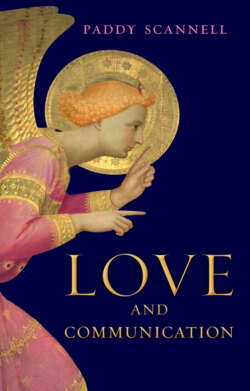Читать книгу Love and Communication - Paddy Scannell - Страница 6
I
ОглавлениеBeing an academic was something that, at the time, I took entirely for granted, but as I got older, I felt an increasing tension between my academic self (me the professor) and my human self (the me-that-I-am, the nonacademic self, a usual person like everyone else). And this tension between my institutional and noninstitutional self runs right through this book. I took the title from a longish review essay, “Love and communication,” that I wrote in 2005 about Speaking into the Air by John Durham Peters (1999). This was and is a book I deeply admire, and especially because it unashamedly brought religious thought into the usual thinking of the academic field I worked in. At that time, it was preoccupied with the politics of communication, the media as cultures of power, and so on. Peters’s book was different. It was focused on religious and philosophical thought in relation to communication, and particularly communication as love, and divine and human versions of it: the difference, as he puts it, between agape and eros. He takes Jesus and Socrates as two paradigm figures who express this difference – Jesus and divine love, Socrates and human love. Their distinctive forms of communication capture the difference between agape and eros.
Socrates to this day is known as a talker, whose mode of philosophizing was dialogue. He famously preferred speech over writing, as Plato (who wrote his dialogue) made clear in what is known as the Phaedrus. As a communicative method it is quite distinct from that of Jesus, whose manner of speaking was exemplified in the parable of the sower. It was a parable about parables, Jesus’s own justification of his method as a communicator. In this story (as written down by his followers), Jesus speaks to a multitude (a mass of people) by the lake of Galilee. Two different approaches to communication. Socrates goes for talk between two people in each other’s presence (the young Phaedrus, and himself) – talk as dialogue. Jesus speaks as one to many – talk as teaching – and it is a one-way, not a two-way process. These two modes of communication are distinguished as insemination (Socrates) and dissemination (Jesus). We, I supposed, naturally prefer two-way over one-way communication. It seems more personal, more genuine, and authentic than one-to-many discourse. But Peters prefers the latter: dissemination over insemination. I had never thought of it this way, but it is surely right. One-way communication is, by definition, nonreciprocal. And in this sense, it is like agape, the love of God, who “gives” without any expectation of thanks and recognition. This for me was a trope for public service broadcasting. The BBC, whose beginnings I had studied in detail, was exemplary (Scannell and Cardiff 1991). In Britain, radio and television were and remain broadcasting institutions. It is a one-to-many communicative system, in which the apparatus “speaks” and multitudes listen and watch. They do not engage in argument. They are not obliged to take heed. The indiscriminate scatter of broadcasting, as in the sowing of seed in the parable, goes everywhere. It is for anyone and everyone, not just some. Insemination (the planting of seed in another) is for the chosen ones, but not radio or television, who began the process of full, democratic, communicative inclusion.
Broadcast radio and television defined (communicatively speaking) the twentieth century and, not by coincidence, their development ran in parallel with the full emergence of a certain version of politics (liberal democracy). This inclusiveness (all in, no one left outside the tent) is the basis of broadcasting. And like the love of God, it is one-way or one-to-many, and nonreciprocal. In what follows, I hold to Peters’s line that there are two kinds of love, divine and human, agape and eros. And each is a different kind of communication. They come together in the end, but the start of the journey lies elsewhere. It reminds me of the old joke about the Englishman lost in the back of beyond in Ireland, trying to find his way to Dublin. He asks a local for help. There is a pause, while the local thinks it over before saying, finally, “Well I wouldn’t start from here.” The local was right, but you have to start from somewhere, and I must clear up some motifs that run through what follows before finally reaching my Dublin. I kick off with human and nonhuman interaction, followed by speech and writing. My goal is the love of God, and everything that follows is working toward this.
